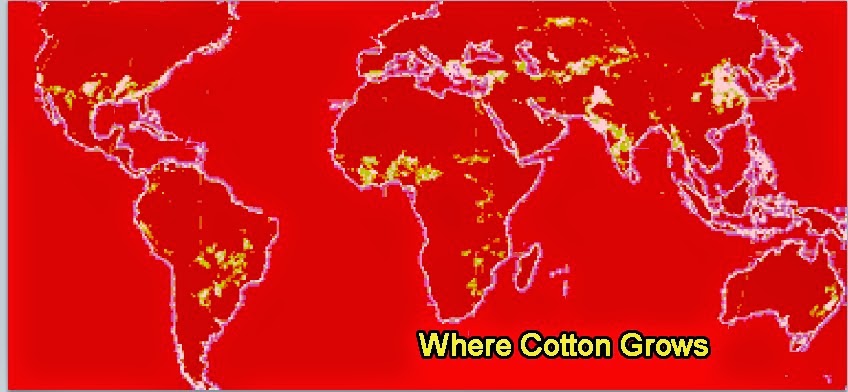Cotton Calendar Girl
1910
When this American pinup was published in 1910, the United States was the world's leading cotton producer. Through our nationalistic lens we continue to view cotton as a distinctly American product.
Empire of Cotton: A Global History by Sven Beckert has changed my view.
Cotton grows in the world's hot climates.
Different soils and weather conditions produce different qualities.
The book, which recently shared the 2015 Bancroft Prize in history, is described by the publisher:
Among the notes I made are lists of various words for the plant and its fiber. Many European languages use a variation of the Arabic qutun.
Arabic: qutun
French: coton
English: cotton
Spanish: algodon (perhaps from al qutun?)
Portuguese: algodão
Dutch: katoen
Italian: cotone
But the Germans have their own word Baumwolle, literally tree-wool.
Another etymology: Beckert traces our word Muslin to the Kurdish word for Mosul, a place too much in the news about Iraq lately.
"The empire of cotton was, from the beginning, a fulcrum of constant global struggle between slaves and planters, merchants and statesmen, workers and factory owners. Beckert makes clear how these forces ushered in the world of modern capitalism, including the vast wealth and disturbing inequalities that are with us today. The result is a book as unsettling as it is enlightening: a book that brilliantly weaves together the story of cotton with how the present global world came to exist."
The book is a 600-plus pages of popular history combined with academic theory (heavy on the theory.) Beckert, co-chair of the Program on the Study of Capitalism at Harvard University, shows us cotton's dominant role in international trade and in the industrial revolution.
Enslaved cotton workers at a
Southern plantation about 1860.
From the Robin Stanford Collection at the Library of Congress
The information that impressed me most was cotton's connection to slavery. I knew, of course, that slaves in the Americas produced much of the world supply before the Civil War, but I did not realize that cotton was the commodity that motivated African slave traders to capture and sell human beings. Africans were not looking for gold. Cotton was the medium of exchange.
Slave traders with women captives.
Painting by Alphonse Lévy about 1875.
Collection of the Musee des Arts Africains et Oceaniens
As the publisher notes, the book is disturbing and unsettling. It's also must-reading for textile historians. Those who long for the good-ole days of American cotton dominance should read it too.
Nostalgia fades with each chapter.
Cotton arriving at a mill in Fresno, Texas,
about 1900
Cotton Spinner in Cherryville, North Carolina.
Photo by Lewis Hine,
Collection at the Library of Congress, about 1910
Arabic: qutun
French: coton
English: cotton
Spanish: algodon (perhaps from al qutun?)
Portuguese: algodão
Dutch: katoen
Italian: cotone
But the Germans have their own word Baumwolle, literally tree-wool.
Another etymology: Beckert traces our word Muslin to the Kurdish word for Mosul, a place too much in the news about Iraq lately.
Woman cotton worker in Calcutta today
Read Karen Long's review in Newsday here:








